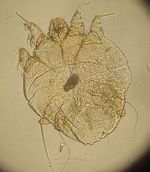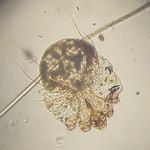Difference between revisions of "Sarcoptes"
| (26 intermediate revisions by 3 users not shown) | |||
| Line 1: | Line 1: | ||
| − | {{ | + | {{OpenPagesTop}} |
| − | + | {{Taxobox | |
| − | [[Image:Sarcoptes scabei | + | |name =''Sarcoptes'' |
| − | [[Image: | + | |phylum =Arthropoda |
| − | + | |class =Arachnida | |
| − | == | + | |order =Sarcoptiformes |
| − | + | |family =Sarcoptidae | |
| − | + | |genus =Sarcoptes | |
| − | + | |species =''S.scabei'' | |
| + | }} | ||
| + | [[Image:Sarcoptes scabei.jpg|thumb|right|150px|''Sarcoptes scabei'' - Kalumet 2004,Wikimedia Commons]] | ||
| + | [[Image:Sarcoptes scabei 2.jpg|thumb|right|150px|''Sarcoptes scabei'' - Kalumet 2004,Wikimedia Commons]] | ||
| + | ==Introduction== | ||
| − | + | Sarcoptes mites are [[Burrowing Mites|burrowing mites]] of dogs and foxes. They Cause [[Sarcoptic Mange]]. The mites prefer hairless skin and so begin on the hocks, elbows and pinnae. The mites are usually spread by direct host to host contact. | |
| − | |||
| − | + | ==Identification== | |
| − | + | Sarcoptes mites are small, round mites. They have short legs that project only a short distance from the body margin. They have dorsal spines arranged in rows and a terminal anus. The male mites are about 250μm in length and the females are about 400-430μm in length. | |
==Life cycle== | ==Life cycle== | ||
| − | |||
| − | + | Sarcoptes mites have a '''3 week''' life cycle. The female lays eggs in the epidermis in an '''egg laying pocket'''. The female feeds on liquid oozing from damaged tissue. The eggs then hatch in 1 week and '''6 legged''' larvae are released. They crawl to skin surface and then burrow back into the epidermis into '''moulting pockets'''. | |
| + | The larvae moult to become '''8 legged''' nymphs. The nymphs moult twice before becoming adults. Adult males then emerge and look for females to mate. | ||
| − | + | ==Diagnosis== | |
| − | + | Mite infection can be diagnosed with a skin scrape of a 'non-scratched' region. The presence of one Sarcoptes mite is diagnostic. | |
| − | + | {{Learning | |
| + | |flashcards = [[Mites_Flashcards|Mites Flashcards]] | ||
| + | |literature search = [http://www.cabdirect.org/search.html?rowId=1&options1=AND&q1=Sarcoptes&occuring1=title&rowId=2&options2=AND&q2=&occuring2=freetext&rowId=3&options3=AND&q3=&occuring3=freetext&publishedstart=2000&publishedend=yyyy&calendarInput=yyyy-mm-dd&la=any&it=any&show=all&x=64&y=11 ''Sarcoptes'' publications since 2000] | ||
| + | |Vetstream = [https://www.vetstream.com/canis/search?s=mite Mites] | ||
| + | }} | ||
| − | |||
| − | + | {{review}} | |
| − | |||
| − | |||
| − | |||
| − | |||
| − | |||
| − | |||
| − | |||
| − | |||
| + | {{OpenPages}} | ||
[[Category:Burrowing Mites]] | [[Category:Burrowing Mites]] | ||
| + | [[Category:Expert_Review]] | ||
Latest revision as of 17:15, 4 June 2016
| Sarcoptes | |
|---|---|
| Phylum | Arthropoda |
| Class | Arachnida |
| Order | Sarcoptiformes |
| Family | Sarcoptidae |
| Genus | Sarcoptes |
| Species | S.scabei |
Introduction
Sarcoptes mites are burrowing mites of dogs and foxes. They Cause Sarcoptic Mange. The mites prefer hairless skin and so begin on the hocks, elbows and pinnae. The mites are usually spread by direct host to host contact.
Identification
Sarcoptes mites are small, round mites. They have short legs that project only a short distance from the body margin. They have dorsal spines arranged in rows and a terminal anus. The male mites are about 250μm in length and the females are about 400-430μm in length.
Life cycle
Sarcoptes mites have a 3 week life cycle. The female lays eggs in the epidermis in an egg laying pocket. The female feeds on liquid oozing from damaged tissue. The eggs then hatch in 1 week and 6 legged larvae are released. They crawl to skin surface and then burrow back into the epidermis into moulting pockets. The larvae moult to become 8 legged nymphs. The nymphs moult twice before becoming adults. Adult males then emerge and look for females to mate.
Diagnosis
Mite infection can be diagnosed with a skin scrape of a 'non-scratched' region. The presence of one Sarcoptes mite is diagnostic.
| Sarcoptes Learning Resources | |
|---|---|
To reach the Vetstream content, please select |
Canis, Felis, Lapis or Equis |
 Test your knowledge using flashcard type questions |
Mites Flashcards |
 Search for recent publications via CAB Abstract (CABI log in required) |
Sarcoptes publications since 2000 |
| This article has been peer reviewed but is awaiting expert review. If you would like to help with this, please see more information about expert reviewing. |
Error in widget FBRecommend: unable to write file /var/www/wikivet.net/extensions/Widgets/compiled_templates/wrt6738efa119f992_25588742 Error in widget google+: unable to write file /var/www/wikivet.net/extensions/Widgets/compiled_templates/wrt6738efa1212991_40192995 Error in widget TwitterTweet: unable to write file /var/www/wikivet.net/extensions/Widgets/compiled_templates/wrt6738efa126bd36_45071774
|
| WikiVet® Introduction - Help WikiVet - Report a Problem |

